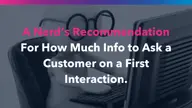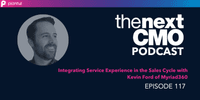A nerd’s recommendation for how much info to ask a customer on a first interaction.

We all had that friend in college who could walk into a bar and secure a phone number from an attractive stranger within 5 minutes. Back in the late 1980s (picture all the hairspray), I had a roommate who was “that guy” – we will call him “Bobby”. I did my best Jane Goodall impression and studied his behavior, and learned that secret was a tolerance for a low conversion rate. I also observed that he missed out on many very nice young women along the way, likely alienating them forever.
Don’t Be a “Bobby” (all the time)
A few decades later, I was reviewing our campaign plans and I thought to myself, “we are acting just like Bobby!” Our digital media plans all had the objective of securing an email along with lots of additional data. Is it wrong to ask prospects for information? No! But for all the people who are willing to share their information, you are missing out on far more people who shyly wait in the background. Some people make the mistake of assuming that they will “make it up in volume” because it is easy to blast a message to hundreds of thousands of people. But it turns out that some people will simply never take the big first step of sharing some information about themselves until you have earned the right.
The right approach is a balanced marketing mix that includes options for immediate engagement with those prospects who are willing to introduce themselves right away, along with options to stay anonymous a little longer.
How to Make Friends Like a Nerd
To understand this a little better, consider the approach that one of “Bobby’s” less outgoing friends might employ when making new friends. Let’s call him “Peter”.
Start by observing
“Peter” would start out by finding some activities that he thinks will attract some nice potential friends. Maybe he could make some friends in the computer club, or the chess club, or even the band.
Once he has found some nice activities that will attract a nice friend, “Peter” would pay attention to some of the things that these new acquaintances seem to find interesting.
Personalize when possible
Now that “Peter” has collected some insights about his new potential friends, he can weave that information into a more personalized interaction. After band practice, he can walk by the young lady and say, “That was a great Sousa march, wasn’t it? He’s my favorite.”
Progressively profile
Based on her reaction, he might start to build a progressive profile, by saying: “Um, ah, um, um, I’m Peter. W-what’s your name?” Armed with a first name and a shared admiration for a composer and conductor of military marches, “Peter” continues to build a relationship until he has earned the trust of his new potential friend to get more information, including the elusive last name, phone number, and Instagram handle.
Building trust makes an enduring friendship
It can take some time, but if you build a relationship respectfully over time, it has a better chance of lasting a long time.
Striking the Balance: When and How to Ask for Information
Does this mean that you can’t ever ask prospects to provide more information? Absolutely not! If a prospect is ready to share information with you right away, you should be ready to collect all the information you can.
Make sure there is an anonymous path
For those people who don’t want to share their details, you need to make sure that you have a way to engage with them in an anonymous manner. There are a few options that should be part of your plan, including:
- Cookie pools for retargeting. When prospects visit your site, you should make sure that you are tracking the visitors (assuming you have the correct privacy provisions and notice in place) so you can retarget them across your digital channels. All the popular digital channels have the ability to track and retarget anonymous visitors in their networks.
- Follows, fans, and likes. Encouraging your prospects to follow your brand on your social channels is a great way to allow them to ease into a relationship with your company. They can maintain their anonymity while they are connected to your messages.
Enable flexible engagement models
When you present your prospect with an opportunity to engage, make sure you allow them to provide the amount of information that they are comfortable sharing. The best approach is to leverage flexible engagement models, including:
- Chat. Conversational marketing products, like those from Drift, are great solutions for flexible engagement. They allow the customer to control the amount of information they are willing to share based on their objective. If they just want some product information and would prefer to stay anonymous, your chatbot can provide them with the product details without requiring identification. If they are ready to start a trial or would like to make a purchase, the conversational interface can ask them to provide the minimally required information to complete the transaction.
- Flexible forms. If you are using simple web forms, make sure that you don’t require too much information. Ideally, your forms will allow for simple logic that will prompt the users to provide relevant information when required (for instance, they need to provide an email if they are looking for an email response.)
Develop the anonymous relationships
Part of your marketing plan should address the anonymous visitors. Just like “Peter” needed to develop a relationship with the young lady in band, you need to develop strategies to engage those visitors and gently bring to them point where they are willing to share additional information.
Remember that your anonymous prospects are an important part of your owned media strategy. You own your cookie pools and your social followers, and it is up to you to develop the content that moves them from their anonymous relationship to a named relationship.
The value of the nerd way
If you intelligently leverage these strategies, you will extract more value from your prospect relationships. The ultimate goal is to convert the people who are ready to share information, but in a much more thoughtful way than the “Bobby” approach. By identifying the prospects who want to engage more accurately, you will alienate fewer people. And by engaging the 95% of prospects who want to stay anonymous in a respectful way, you will start to move those anonymous visitors to the point where they are ready to engage.

